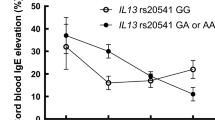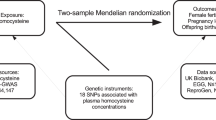Abstract
Background/Objectives:
Riboflavin is a cofactor for the 5,10-methylenetetrahydrofolate reductase (MTHFR) enzyme involved in the homocysteine pathway. The aim of this study was to investigate the effects of maternal riboflavin intake and two MTHFR polymorphisms (677C>T; Ala222Val and 1298A>C; Glu429Ala substitutions) on the biomarkers of the homocysteine pathway, and investigate the risk of having offspring with an orofacial cleft (OFC).
Subjects/Methods:
In a case–control study design, dietary riboflavin intake and the MTHFR 677C>T and 1298A>C polymorphisms were evaluated in 123 OFC and 108 control mothers by using food frequency questionnaires and blood samples. Homocysteine (tHcy), folate and vitamin B12 concentrations in blood were analyzed in 70 cases and 68 controls. Linear and logistic regression analyses were applied.
Results:
At 14 months postpartum riboflavin intake and MTHFR 677C>T and 1298A>C genotypes were not significantly different between cases and controls. The 677TT genotype showed lower folate concentrations compared to C-allele carriers with a mean difference of 2.8 nmol/l in serum and 174 nmol/l in red blood cell (both P's=0.01). Every mg per day increase of dietary riboflavin intake was positively associated with increase in vitamin B12 concentration by 52.1% (P<0.01). This effect was most pronounced in MTHFR 677TT homozygotes (205.1%, P=0.03). The riboflavin-adjusted MTHFR 677TT and 1298CC genotypes showed a trend toward an increasing risk for OFC, adjusted odds ratio 1.7 (confidence interval (95% CI), 0.7–4.5) and 1.6 (95% CI, 0.7–4.2), respectively.
Conclusions:
Maternal riboflavin intake is significantly associated with biomarkers of the homocysteine pathway, with the strongest effects in MTHFR 677TT homozygotes. The maternal risk of having OFC offspring, however, is not associated with dietary riboflavin intake.
This is a preview of subscription content, access via your institution
Access options
Subscribe to this journal
Receive 12 print issues and online access
$259.00 per year
only $21.58 per issue
Buy this article
- Purchase on Springer Link
- Instant access to full article PDF
Prices may be subject to local taxes which are calculated during checkout
Similar content being viewed by others
References
De Bree A, Verschuren WM, Blom HJ, Kromhout D (2001). Association between B vitamin intake and plasma homocysteine concentration in the general Dutch population aged 20–65 y. Am J Clin Nutr 73, 1027–1033.
Delgado-Rodriguez M, Llorca J (2004). Bias. J Epidemiol Community Health 58, 635–641.
Devine CM, Bove CF, Olson CM (2000). Continuity and change in women's weight orientations and lifestyle practices through pregnancy and the postpartum period: the influence of life course trajectories and transitional events. Soc Sci Med 50, 567–582.
Fodinger M, Horl WH, Sunder-Plassmann G (2000). Molecular biology of 5,10-methylenetetrahydrofolate reductase. J Nephrol 13, 20–33.
Friso S, Girelli D, Trabetti E, Stranieri C, Olivieri O, Tinazzi E et al. (2002). A1298C methylenetetrahydrofolate reductase mutation and coronary artery disease: relationships with C677 T polymorphism and homocysteine/folate metabolism. Clin Exp Med 2, 7–12.
Frosst P, Blom HJ, Milos R, Goyette P, Sheppard CA, Matthews RG et al. (1995). A candidate genetic risk factor for vascular disease: a common mutation in methylenetetrahydrofolate reductase. Nat Genet 10, 111–113.
Hayes C, Werler MM, Willett WC, Mitchell AA (1996). Case–control study of periconceptional folic acid supplementation and oral clefts. Am J Epidemiol 143, 1229–1234.
Hustad S, McKinley MC, McNulty H, Schneede J, Strain JJ, Scott JM et al. (2002). Riboflavin, flavin mononucleotide, and flavin adenine dinucleotide in human plasma and erythrocytes at baseline and after low-dose riboflavin supplementation. Clin Chem 48, 1571–1577.
Hustad S, Midttun O, Schneede J, Vollset SE, Grotmol T, Ueland PM (2007). The methylenetetrahydrofolate reductase 677C → T polymorphism as a modulator of a B vitamin network with major effects on homocysteine metabolism. Am J Hum Genet 80, 846–855.
Infante-Rivard C, Jacques L (2001). Empirical study of parental recall bias. Am J Epidemiol 152, 480–486.
International Centre on Birth Defects (2007). ICBDSR Annual Report 2007 with data for 2005. The Centre of the International Clearinghouse for Birth Defects Surveillance and Research. A non-governmental organisation in official relations with the World Health Organization: Roma, Italy, ISSN 0743-5703: http://www.icbdsr.org/filebank/documents/ar2005/Report2007.pdf
Jacques PF, Bostom AG, Wilson PW, Rich S, Rosenberg IH, Selhub J (2001). Determinants of plasma total homocysteine concentration in the Framingham Offspring cohort. Am J Clin Nutr 73, 613–621.
Jacques PF, Kalmbach R, Bagley PJ, Russo GT, Rogers G, Wilson PW et al. (2002). The relationship between riboflavin and plasma total homocysteine in the Framingham Offspring cohort is influenced by folate status and the C677 T transition in the methylenetetrahydrofolate reductase gene. J Nutr 132, 283–288.
Khoury MJ, James LM, Erickson JD (1994). On the use of affected controls to address recall bias in case–control studies of birth defects. Teratology 49, 273–281.
Konstantinova SV, Vollset SE, Berstad P, Ueland PM, Drevon CA, Refsum H et al. (2007). Dietary predictors of plasma total homocysteine in the Hordaland Homocysteine Study. Br J Nutr 98, 201–210.
Krapels IP, van Rooij IA, Ocke MC, van Cleef BA, Kuijpers-Jagtman AM, Steegers-Theunissen RP (2004). Maternal dietary B vitamin intake, other than folate, and the association with orofacial cleft in the offspring. Eur J Nutr 43, 7–14.
Krapels IP, Vermeij-Keers C, Muller M, de Klein A, Steegers-Theunissen RP (2006). Nutrition and genes in the development of orofacial clefting. Nutr Rev 64, 280–288.
Kuemmerle SC, Boltinghouse GL, Delby SM, Lane TL, Simondsen RP (1992). Automated assay of vitamin B-12 by the Abbott IMx analyzer. Clin Chem 38, 2073–2077.
Leck I, Iles CA, Sharman IM, Toe T, Wadsworth GR (1974). Proceedings: a study of the extent to which maternal nutrition after delivery reflects the situation in early pregnancy. Br J Prev Soc Med 28, 66.
McKinley MC, McNulty H, McPartlin J, Strain JJ, Scott JM (2002). Effect of riboflavin supplementation on plasma homocysteine in elderly people with low riboflavin status. Eur J Clin Nutr 56, 850–856.
McNulty H, Dowey le RC, Strain JJ, Dunne A, Ward M, Molloy AM et al. (2006). Riboflavin lowers homocysteine in individuals homozygous for the MTHFR 677C → T polymorphism. Circulation 113, 74–80.
Moat SJ, Ashfield-Watt PA, Powers HJ, Newcombe RG, McDowell IF (2003). Effect of riboflavin status on the homocysteine-lowering effect of folate in relation to the MTHFR (C677 T) genotype. Clin Chem 49, 295–302.
Molloy AM, Scott JM (1997). Microbiological assay for serum, plasma, and red cell folate using cryopreserved, microtiter plate method. Methods Enzymol 281, 43–53.
Netherlands Nutrition Centre (1996). NEVO: Dutch Food Composition Database. Netherlands Nutrition Centre: the Hague, the Netherlands.
Ocke MC, Bueno-de-Mesquita HB, Goddijn HE, Jansen A, Pols MA, van Staveren WA et al. (1997a). The Dutch EPIC food frequency questionnaire. I. Description of the questionnaire, and relative validity and reproducibility for food groups. Int J Epidemiol 26 (Suppl 1), S37–S48.
Ocke MC, Bueno-de-Mesquita HB, Pols MA, Smit HA, van Staveren WA, Kromhout D (1997b). The Dutch EPIC food frequency questionnaire. II. Relative validity and reproducibility for nutrients. Int J Epidemiol 26 (Suppl 1), S49–S58.
Renz P (1970). Riboflavin as precursor in the biosynthesis of the 5,6-dimethylbenzimidazole-moiety of vitamin B(12). FEBS Lett 6, 187–189.
Shaw GM, Lammer EJ, Wasserman CR, O'Malley CD, Tolarova MM (1995). Risks of orofacial clefts in children born to women using multivitamins containing folic acid periconceptionally. Lancet 346, 393–396.
Taga ME, Larsen NA, Howard-Jones AR, Walsh CT, Walker GC (2007). BluB cannibalizes flavin to form the lower ligand of vitamin B12. Nature 446, 449–453.
te Poele-Pothoff MT, van den Berg M, Franken DG, Boers GH, Jakobs C, de Kroon IF et al. (1995). Three different methods for the determination of total homocysteine in plasma. Ann Clin Biochem 32 (Part 2), 218–220.
van Driel LM, Zwolle LJ, Boxmeer JC, de Vries JH, Helbing WA, Steegers EA et al. (2009). The maternal nutritional status at one year after delivery is comparable with the preconception period. Reprod Sci 16 (Suppl), 239A.
van Rooij IA, Ocke MC, Straatman H, Zielhuis GA, Merkus HM, Steegers-Theunissen RP (2004). Periconceptional folate intake by supplement and food reduces the risk of nonsyndromic cleft lip with or without cleft palate. Prev Med 39, 689–694.
van Rooij IA, Vermeij-Keers C, Kluijtmans LA, Ocke MC, Zielhuis GA, Goorhuis-Brouwer SM et al. (2003). Does the interaction between maternal folate intake and the methylenetetrahydrofolate reductase polymorphisms affect the risk of cleft lip with or without cleft palate? Am J Epidemiol 157, 583–591.
Weisberg I, Tran P, Christensen B, Sibani S, Rozen R (1998). A second genetic polymorphism in methylenetetrahydrofolate reductase (MTHFR) associated with decreased enzyme activity. Mol Genet Metab 64, 169–172.
Willett WC, Howe GR, Kushi LH (1997). Adjustment for total energy intake in epidemiologic studies. Am J Clin Nutr 65, 1220S–1228S; discussion 1229S-1231S.
Yamada K, Chen Z, Rozen R, Matthews RG (2001). Effects of common polymorphisms on the properties of recombinant human methylenetetrahydrofolate reductase. Proc Natl Acad Sci USA 98, 14853–14858.
Acknowledgements
This study was supported by a grant of the Royal Netherlands Academy of Arts and Sciences (KNAW), Amsterdam, the Netherlands (1997) and the Mother and Child Centre, Department of Obstetrics and Gynaecology, Division of Obstetrics and Prenatal Medicine, Erasmus University Medical Centre, Rotterdam, the Netherlands.
Author information
Authors and Affiliations
Corresponding author
Additional information
Contributors: MV performed statistical analysis of the data and drafted the first version of the paper. JvM and AGU were involved in the interpretation of the data and all revisions of the paper. NY contributed to the statistical analysis and all revisions of the paper. IAvR carried out the data collection and contributed to the final version of the paper. EAS supervised the study and contributed to all revisions of the paper. RPS-T initiated the study, hypothesis, design, supervised the study, contributing to all versions of the paper.
Rights and permissions
About this article
Cite this article
Vujkovic, M., Steegers, E., van Meurs, J. et al. The maternal homocysteine pathway is influenced by riboflavin intake and MTHFR polymorphisms without affecting the risk of orofacial clefts in the offspring. Eur J Clin Nutr 64, 266–273 (2010). https://doi.org/10.1038/ejcn.2009.138
Received:
Revised:
Accepted:
Published:
Issue Date:
DOI: https://doi.org/10.1038/ejcn.2009.138
Keywords
This article is cited by
-
Potential value of nutrigenomics in Crohn's disease
Nature Reviews Gastroenterology & Hepatology (2012)



